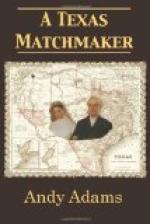We usually camped two or three days at a place, taking in both sides of the river, and after the work was once well under way we kept our wagon busy hauling the dry hides to a common yard on the river opposite Las Palomas. Without apology, it can be admitted that we did not confine our killing to the Las Palomas brand alone, but all cumberers on our range met the same fate. There were numerous stray bulls belonging to distant ranches which had taken up their abode on the Nueces, all of which were fish to our net. We kept a brand tally of every bull thus killed; for the primary motive was not one of profit, but to rid the range of these drones.
When we had been at work some two weeks, we had an exciting chase one afternoon in which Enrique Lopez figured as the hero. In coming in to dinner that day, Uncle Lance told of the chase after a young ladino bull with which we were all familiar. The old ranchero’s hatred to wild cattle had caused him that morning to risk a long shot at this outlaw, wounding him. Juan Leal and Enrique Lopez, who were there, had both tried their marksmanship and their ropes on him in vain. Dragging down horses and snapping ropes, the bull made his escape into a chaparral thicket. He must have been exceedingly nimble; for I have seen Uncle Lance kill a running deer at a hundred yards with a rifle. At any rate, the entire squad turned out after dinner to renew the attack. We saddled the best horses in our remuda for the occasion, and sallied forth to the lair of the ladino bull, like a procession of professional bull-fighters.
The chaparral thicket in which the outlaw had taken refuge lay about a mile and a half back from the river and contained about two acres. On reaching the edge of the thicket, Uncle Lance called for volunteers to beat the brush and rout out the bull. As this must be done on foot, responses were not numerous. But our employer relieved the embarrassment by assigning vaqueros to the duty, also directing Enrique to take one point of the thicket and me the other, with instructions to use our ropes should the outlaw quit the thicket for the river. Detailing Tiburcio, who was with us that afternoon, to assist him in leading the loose saddle horses, he divided the six other men into two squads under Theodore Quayle and Dan Happersett. When all was ready, Enrique and myself took up our positions, hiding in the outlying mesquite brush; leaving the loose horses under saddle in the cover at a distance. The thicket was oval in form, lying with a point towards the river, and we all felt confident if the bull were started he would make for the timber on the river. With a whoop and hurrah and a free discharge of firearms, the beaters entered the chaparral. From my position I could see Enrique lying along the neck of his horse about fifty yards distant; and I had fully made up my mind to give that bucolic vaquero the first chance. During the past two weeks my enthusiasm for roping stray bulls




